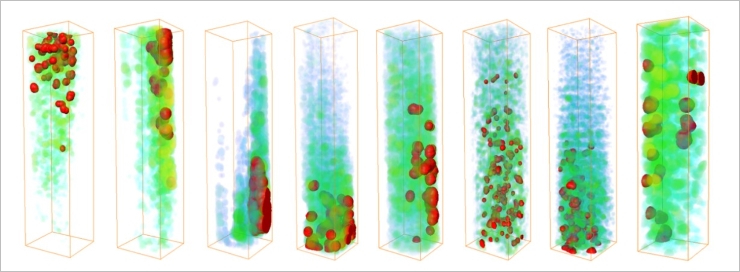JINR specialists developing and studying compositions of durable cement for radioactive waste storage
News, 11 August 2023
A group of scientists at the Laboratory of Neutron Physics at JINR has studied cement samples with various inclusions used for long-term conditioning – one of the key stages of radioactive waste treatment. Experiments with methods of non-destructive microstructural neutron analysis have resulted in the determination of cement matrices with high mechanical stability characteristics. According to the scientists, the obtained results could become a promising basis for further research of cement compositions of new types.
Radioactive waste is produced in all areas of the nuclear industry – at nuclear power plants and research reactors, radiochemical industries, enterprises that maintain ships with nuclear power facilities, industrial enterprises that use radionuclides, in medical centres. One of the simplest and most effective ways to process them is cementation – specialists put the waste in an airtight container and fill it with mortar. Since the materials required for the cementation are relatively cheap, this method of processing radioactive waste is one of the most cost-effective and reliable solutions.
For waste processing, specialists are currently and actively developing new chemical compositions for cement materials, the so-called cement matrices, along with synthesis methods. These tasks are complicated by strict requirements for technological parameters and durability of the final product. At this point, structural diagnostics of new compositions or ready-made cement materials comes to the fore. FLNP JINR scientists have been conducting similar studies of cement matrices for conditioning radioactive waste of various types since 2018.
This team of scientists has recently started solving the problem of finding the optimal composition of cement paste for processing metal aluminium waste. It was required that after the solidification process of cement matrix, the final material had a low permeability rate of water and alkaline solutions inside the volume. The presented results obtained in cooperation with colleagues at the Horia Hulubei National Institute of Physics and Engineering, Romania, and Nuclear Research Centre, the Egyptian Atomic Energy Authority (EAEA), Egypt.
“Even for civil facilities, a water permeability rate of cement-based materials is a significant problem. As for radioactive waste storage, to prevent water outside from permeating into already made materials becomes one of the key tasks,” Sergey Kichanov, one of the authors of the study, an employee of the Scientific and Experimental Department of Neutron Investigations of Condensed Matter (DNICM) at FLNP JINR, noted. The scientists explained that the durability of a cement-based compound, a solid mixture of cement and waste prepared for storage, is firstly determined by its porosity and cracking.
“This is explained by the fact that a minimal porosity of cement-based materials determines their resistance to chemical degradation, deep permeability of surface water, resistance to cold cracking of cement materials. To date, it is a well-known fact that cracks and pores are easy ways for water or water solutions to permeate into structural cement materials. This process often seriously deteriorates the condition of building constructions,” Sergey Kichanov highlighted.
In their experiments, scientists studied new composites with the addition of organic and inorganic components to cement paste. As for the composite basis, they took affordable ordinary Portland cement. They added aluminium to the obtained compositions to assess structural characteristics of the paste. Thus, during the process of selecting and assessing materials suitable for conditioning radioactive metallic aluminium, specialists prepared eight samples with organic and inorganic additives obtained from two types of cement matrices, namely CEM III-A and CEM V-A.
To identify and analyse the structural characteristics of cement-based materials, such as the presence of internal cracks and cavities, a porosity rate, scientists have used the method of neutron radiography and tomography. This method of non-destructive structural analysis allows specialists to obtain neutron images and three-dimensional reconstructions of the internal structure of objects with a spatial resolution of more than 100 μm. To get three-dimensional images, which illustrate the spatial arrangement of cement components, specialists studied all samples at the neutron radiography and tomography station at the IBR-2 Research Reactor at FLNP JINR.
As a result, specialists found water-containing micro-volumes and pores that formed clusters or aggregates with diameters up to 0.6-0.8 mm in some samples. While another samples had a low degree of porosity. Researchers calculated porosity values and moisture absorption coefficients for each of the samples within the capillary model, analysed abnormal moisture absorption processes, studied the dependence of water absorption on the peculiarities of the preparation of cement matrices, as well as the processes of water permeability into reinforced cement materials.
“The research has shown that organic components added to cement paste prevented the formation of cracks and pores in the final compositions,” FLNP JINR researcher Ivan Zel noted. “Organic components take away the excess of gases formed during the synthesis process.”
 Reconstructed three-dimensional models with analysis of the spatial localization of water-rich zones (indicated in red) inside the studied cement fragments according to neutron tomography
Reconstructed three-dimensional models with analysis of the spatial localization of water-rich zones (indicated in red) inside the studied cement fragments according to neutron tomography
The obtained results, according to the scientists, are important for the development of new technologies and modernisation of existing ones for the creation of promising cement-based materials aimed at the construction of radioactive waste storage and civil facilities. Moreover, the research results will help predict the influence of external conditions, such as climate humidity, precipitation, etc. on the mechanical and physical properties of these materials.
In 2022, a team of scientists at the Laboratory received the Second Prize of the Joint Institute for Nuclear Research in the Applied Physics Research section for the non-destructive microstructural analysis of promising cement materials for the construction of radioactive waste storage and civil facilities and the obtained results of neutron radiography and tomography.